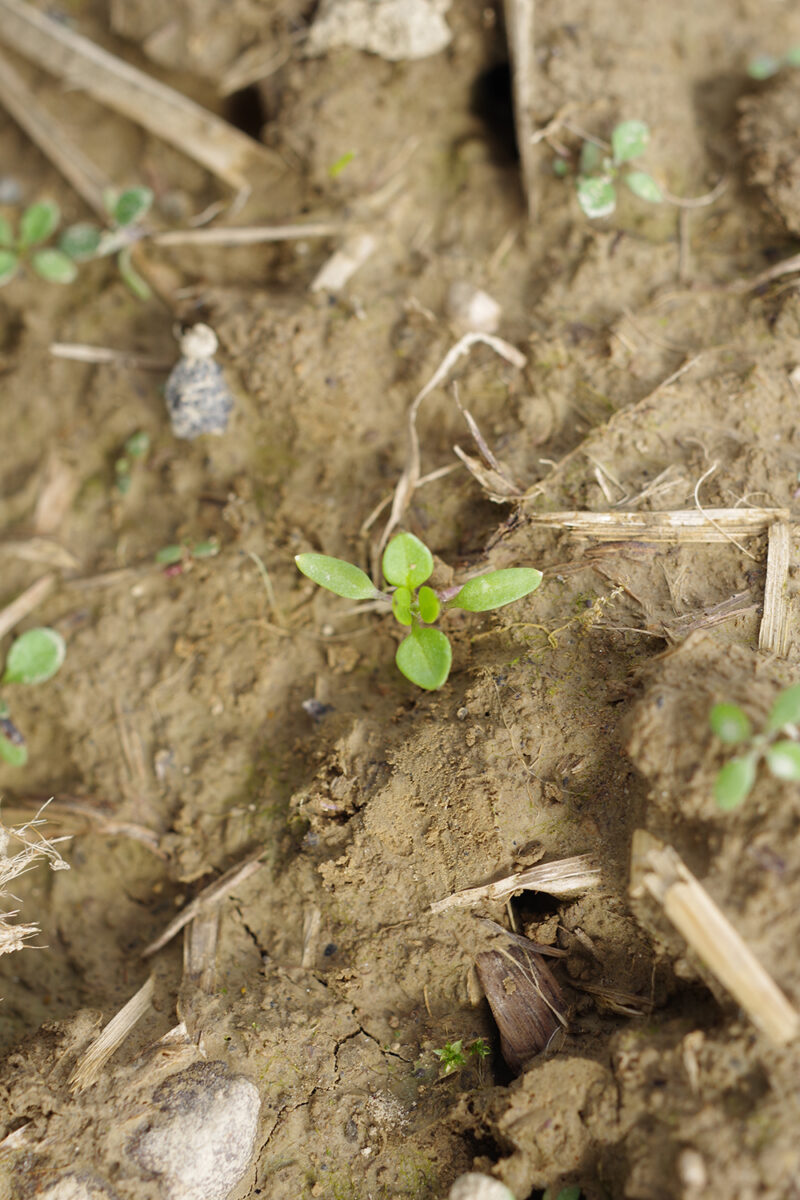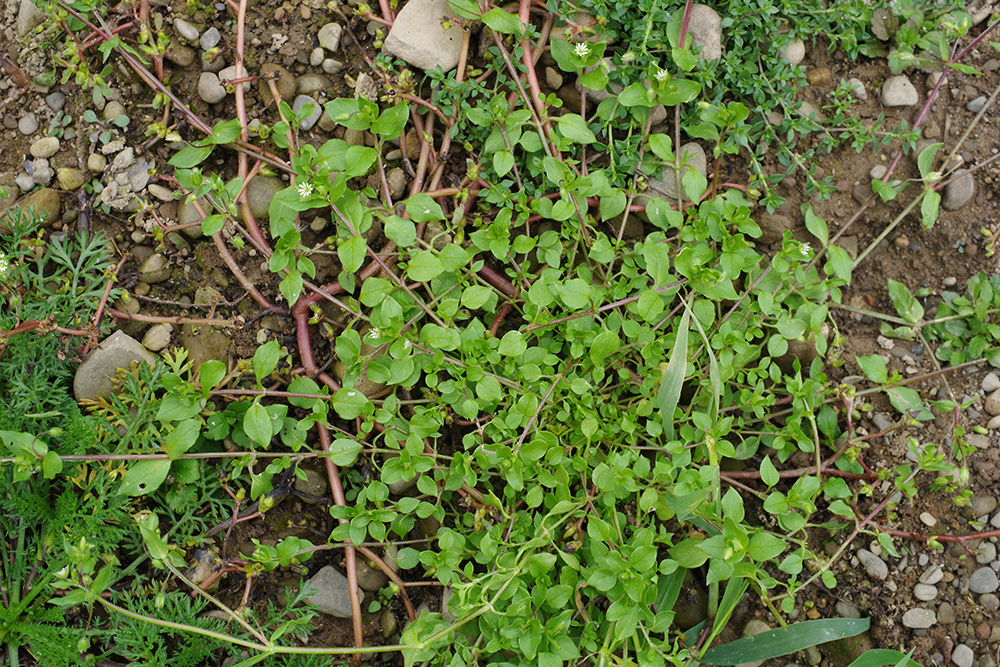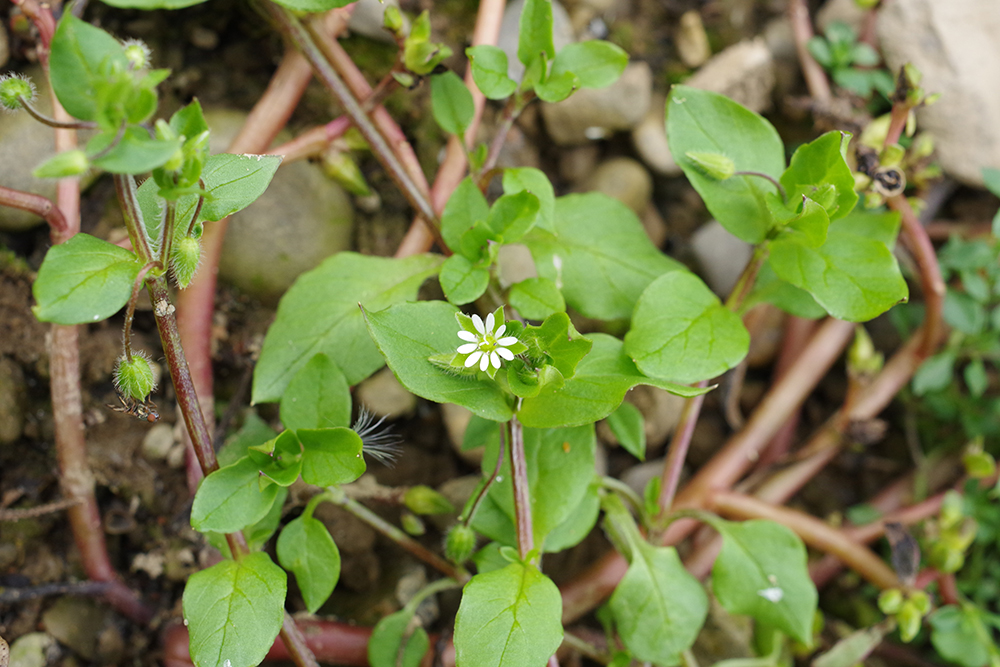Other common names: starwort, starweed, bindweed, winter weed, satin flower, tongue grass, chickwhirtles, cluckenweed, mischievous Jack, skirt buttons, cyrillo, white bird’s eye, common starwort



Stellaria media (L.) Vill.
Identification of Chickweed
Family: Pink family, Caryophyllaceae
Habit: Mat forming winter or summer annual herb
Description: Seedling cotyledons are oval, 0.4 inch long by 0.1 inch wide, pointed at the tip and borne on a 0.4 inch-long hairy stalk. True leaves are opposite, round to teardrop shaped and twice the length of the stalk. Seedlings are light green, upright and about the width of a penny at the four true leaf stage. Branching starts at the five leaf-pair stage. Mature plants form dense, light green carpets of foliage with creeping stems up to 20 inches long. Stem tips are angled upward, helping the stems crawl over and onto other plants. Stems branch often, root at the nodes when in contact with the soil and are smooth except for one to two rows of small hairs. Leaves are oppositely arranged and located on 0.25–0.75 inch-long stalks, which may be absent near branch tips. One line of white hairs is present on stalks. Leaves are broadly teardrop to elliptically shaped, pointed at the tip and 0.4–1.25 inch long by 0.6 inch wide. Upper leaves are no wider than 0.4 inch. Shallow, fibrous roots easily break from the shoots. Mats may reach 0.3–3.3 feet in diameter. Flowers have five deeply lobed, white petals set inside five larger, green, 0.2 inch long, triangular sepals. The 0.1–0.3 inch diameter flowers are clustered at branch ends. Each flower produces an oval, single chambered capsule containing eight to 10 light yellow-brown to red-brown, irregularly round, flat, 0.06 inch diameter seeds with a pebbly surface. The capsule splits to form six teeth when releasing seeds and is retained on the plant.
Similar species: Leaves of mouseear chickweed [Cerastium fontanum Baumg. ssp. fontanum] are densely covered in fine hairs at all growth stages. Thymeleaf speedwell (Veronica serpyllifolia L.) has rounded, lightly toothed, dark green leaves with notched tips and no hairs on its stems or leaf stalks; its flowers have four white petals with blue streaks. Thymeleaf sandwort (Arenaria serpyllifolia L.) has hairy leaves and five non-divided petals. Little starwort (Stellaria graminea L.) has flowers similar to common chickweed, but they are borne on long stalks, and plants have long, tapering leaves.
Management of Chickweed
Because common chickweed can grow and set seeds during any season of the year, control throughout all crop rotation phases should be practiced. Otherwise, high densities of seeds may build up in the soil and overwhelm control efforts in crops that are sensitive to common chickweed competition. Thus, for example, flame weeding sweet corn very effectively controls common chickweed and may be worthwhile to prevent competition with subsequent crops, even though common chickweed causes little yield loss in corn. If common chickweed is a problem, sowing density of winter cover crops should be increased. Increased sowing density of both winter and spring grain crops may help reduce yield losses to common chickweed and will also reduce seed production. Because chickweed continues to grow and set seed until it dies, tilling fields immediately after harvest is important in controlling this species. If the species is green and growing, one or two weeks of delay can increase seed production by several fold.
Because common chickweed seedlings are very small and fragile, stirring of the top 1–2 inches of soil two to four times during the first month following tillage is highly effective at removing many of the individuals that will emerge during the season. Since stems root readily in moist soil, cultivation is often ineffective once the plant mat reaches several inches in diameter. Thus, frequent but shallow weeding is more effective at controlling the species. Harrowing in the spring is more effective than fall harrowing for controlling this species in winter wheat. Since most common chickweed seeds that have been incorporated into the soil remain dormant unless exposed to light, flame weeding to create a stale seedbed before planting small seeded or slow growing vegetables is advantageous. Organic mulch materials are effective for suppressing common chickweed due to the species' small seed reserves and prostrate growth form. Common chickweed is highly shade tolerant, however, and can scramble up through loose straw. Thus, plastic mulch, baled straw or a paper barrier under loose straw will be more effective than loose straw alone.
Ecology of Chickweed
Origin and distribution: Common chickweed is native to Europe. It has been widely introduced throughout the world, including parts of the far north and sub-Antarctic islands. In the tropics it occurs primarily at high elevations. It occurs in all 50 states and in all Canadian provinces, but it is generally absent from dry areas.
Seed weight: Seed weight varies between populations, with mean seed weights ranging from 0.36–0.51 mg.
Dormancy and germination: Freshly shed seeds are typically dormant, but some may germinate immediately in some populations. A period of after-ripening at warm soil temperatures (for example, 68°F) breaks dormancy. Thus, most seeds shed in the spring wait until fall to germinate. In addition, a low temperature requirement for after-ripening has been reported. Seeds germinate best at moderate temperatures of 54–68°F and will not germinate at temperatures above 86°F. Once seeds have after-ripened, light, fluctuating temperature and nitrate all promote germination, but light is the most important germination cue. Different populations can possess different after-ripening and environmental requirements for germination, presumably permitting the species to germinate in response to varying conditions.
Seed longevity: Viable seeds of common chickweed have been found beneath medieval ruins in Europe. Deep burial in high moisture, low oxygen conditions is highly favorable for seed survival. Seeds stored under dry, cool laboratory conditions remained viable for 5.5 years. In cool Alaskan conditions, buried common chickweed had a 17% annual mortality rate, but a few seeds were still viable after 24.7 years. Most common chickweed seeds die off quickly, however, in regularly tilled soil. In one study, seed viability declined annually by 19–30% in undisturbed soil but by 34–56% under cultivated conditions. In several other studies in annually tilled fields, common chickweed seeds declined at 33–60% per year. In soil stirred four times per year, seeds declined by 72% per year. Seeds buried in Mississippi lost all viability in 18 months.
Season of emergence: Although common chickweed can emerge any time of year in moist soil at moderate temperatures, most emergence occurs during the spring and fall.
Emergence depth: Optimum depth for emergence is from just below the surface at 0.4 inch. Seedlings will emerge from seeds as deep as 2 inches, but emergence from deeper is rare.
Photosynthetic pathway: C3
Sensitivity to frost: Common chickweed can tolerate temperatures down to 7°F, though with some damage. Photosynthesis can occur at temperatures below freezing, and the base temperature for growth of this species was computed to be 26°F. In the Northeast, fall germinating seedlings commonly persist through the winter.
Drought tolerance: The species is drought sensitive, and plants quickly wilt and die during dry conditions.
Mycorrhiza: Most studies have found no mycorrhiza, but one report indicated slight mycorrhizal presence.
Response to fertility: Common chickweed prefers highly fertile soils, and its dense root system is well adapted to access nutrients. Biomass, seed production and seed weight increase with increasing nitrogen. Common chickweed is highly responsive to addition of P when N is adequate. In excessively fertile conditions like manure piles, it concentrates nitrate to toxic levels. Even in agricultural fields, nutrient levels in common chickweed tissues can be high. For example, plants from a Massachusetts onion field had elemental N-P-K levels of 3.4-0.53-7.5 whereas levels in the onions were 2-0.28-2.2. The species grows well on soil with a pH from 5.2–8.2, but growth is severely depressed below pH 5.2.
Soil physical requirements: The species tolerates a wide range of soil types but grows best on moist, fine textured soils.
Response to shade: Common chickweed is shade tolerant. It grows well in partial shade and can flower and set seeds in as little as 1.5% daylight.
Sensitivity to disturbance: Small seedlings are easily killed by cultivation. Larger plants may reroot following cultivation or hoeing if the plant is partially covered with soil. Stems root when in contact with moist soil, which makes large plants difficult to completely remove by pulling. Its low, prostrate growth habit allows it to survive repeated mowings, as occurs with hay or green manure crops.
Time from emergence to reproduction: Plants usually flower within six weeks of emergence, and seeds set about two weeks later. Since some freshly shed seeds are not dormant or can after-ripen rapidly, the species can complete three to four generations per year. The timing of 50% seed production in Michigan occurs between mid-May and mid-June.
Pollination: Common chickweed usually self-pollinates, and under cold conditions, pollination may occur without opening of the flowers.
Reproduction: Common chickweed flowering is independent of day length, and this species can set seed at any time of the year provided moisture is available and temperatures are above freezing. Flowering and seed set occur continuously as the plant grows. Mature plants typically produce 500–3,000 seeds each, but very large plants may produce 13,000–15,000 seeds.
Dispersal: The seeds have no special adaptations for dispersal, but it has been spread worldwide primarily by humans because of its adaptability to disturbed habitats. Most dispersal probably occurs in soil clinging to shoes, tires, farm implements and animal hooves. Some seeds retain viability when passing through the digestive tracts of cattle, sheep, horses, deer, rabbits, pigs and some birds, including sparrows and gulls. Seeds are also dispersed as a contaminant of pasture seed and other crops.
Common natural enemies: Several species of wildlife graze common chickweed, and several species of insects, nematodes and disease organisms are found associated with this species, but the level of damage is usually trivial.
Palatability: Common chickweed has a mild flavor that makes it palatable as a salad herb. It is nutritious fodder for cows, sheep, horses, pigs and chickens, but it may contain toxic levels of nitrate when grown on nitrogen rich soils.
Summary Table of Chickweed Characteristics
| Common chickweed | ||||||||
|---|---|---|---|---|---|---|---|---|
| Growth habit | Seed weight (mg) | Seed dormancy at shedding | Factors breaking dormancy | Optimum temperature for germination (F) | Seed mortality in untilled soil (%/year) | Seed mortality in tilled soil (%/year) | Typical emergence season | Optimum emergence depth (inches) |
| short, matting | 0.36–0.51 | Yes | wst, li, at, ni | 54–68 | 17–30 | 33–72 | fall and spring | 0–0.4 |
| Photosynthesis type | Frost tolerance | Drought tolerance | Mycorrhiza | Response to nutrients | Emergence to flowering (weeks) | Flowering to viable seed (weeks) | Pollination | Typical & high seed production (seeds per plant) |
| C3 | high | low | no | high | 6 | 2 | self | 1,500 & 15,000 |
Table Key
General: The designation “–” signifies that data is not available or the category is not applicable.
Growth habit: A two-word description; the first word indicates relative height (tall, medium, short, prostrate) and second word indicates degree of branching (erect, branching, vining).
Seed weight: Range of reported values in units of “mg per seed.”
Seed dormancy at shedding: “Yes” if most seeds are dormant when shed, “Variable” if dormancy is highly variable, “No” if most seeds are not dormant.
Factors breaking dormancy: The principle factors that are reported to break dormancy and facilitate germination. The order of listing does not imply order of importance. Abbreviations are:
scd = seed coat deterioration
cms = a period subjected to cold, moist soil conditions
wst = warm soil temperatures
li = light
at = alternating day-night temperatures
ni = nitrates
Optimum temperature range for germination: Temperature (Fahrenheit) range that provides for optimum germination of non-dormant seeds. Germination at lower percentages can occur outside of this range. The dash refers to temperature range, and the slash refers to alternating day/night temperature amplitudes.
Seed mortality in untilled soil: Range of mortality estimates (percentage of seed mortality in one year) for buried seeds in untilled soil. Values were chosen where possible for seeds placed at depths below the emergence depth for the species and left undisturbed until assessment. Mortality primarily represents seed deterioration in soil.
Seed mortality in tilled soil: Range of mortality estimates (percentage of seed mortality in one year) for seeds in tilled soil. Values were chosen for seeds placed within the tillage depth and subjected to at least annual tillage events. Seed losses are the result of dormancy-breaking cues induced by tillage, germination and deterioration of un-germinated seeds.
Typical emergence season: Time of year when most emergence occurs in the typical regions of occurrence for each weed. Some emergence may occur outside of this range.
Optimum emergence depth: Soil depths (in inches below the soil surface) from which most seedlings emerge. Lower rates of emergence usually will occur at depths just above or just below this range.
Photosynthesis type: Codes “C3” or “C4” refer to the metabolic pathway for fixing carbon dioxide during photosynthesis. Generally, C3 plants function better in cooler seasons or environments and C4 plants function better in warmer seasons or environments.
Frost tolerance: Relative tolerance of plants to freezing temperatures (high, moderate, low).
Drought tolerance: Relative tolerance of plants to drought (high, moderate, low).
Mycorrhiza: Presence of mycorrhizal fungi. “Yes” if present; “no” if documented not to be present, “unclear” if there are reports of both presence and absence; “variable” if the weed can function either with or without, depending on the soil environment.
Response to nutrients: Relative plant growth response to the nutrient content of soil, primarily N, P, K (high, moderate, low).
Emergence to flowering: Length of time (weeks) after emergence for plants to begin flowering given typical emergence in the region of occurrence. For species emerging in fall, “emergence to flowering” means time from resumption of growth in spring to first flowering.
Flowering to viable seed: Length of time (weeks) after flowering for seeds to become viable.
Pollination: “Self” refers to species that exclusively self-pollinate, “cross” refers to species that exclusively cross-pollinate, “self, can cross” refer to species that primarily self-pollinate, but also cross-pollinate at a low rate, and “both” refers to species that both self-pollinate and cross-pollinate at relatively similar rates.
Typical and high seed production potential: The first value is seed production (seeds per plant) under typical conditions with crop and weed competition. The second value, high seed production, refers to conditions of low density without crop competition. Numbers are rounded off to a magnitude that is representative of often highly variable reported values.
Further Reading
Hill, E.C., K.A. Renner and C.L. Sprague. 2014. Henbit (Lamium amplexicaule), common chickweed (Stellaria media), shepherd's-purse (Capsella bursa-pastoris), and field pennycress (Thlaspi arvense): Fecundity, seed dispersal, dormancy, and emergence. Weed Science 62: 97–106.
Mertens, S.K. and J. Jansen. 2002. Weed seed production, crop planting pattern, and mechanical weeding in wheat. Weed Science 50: 748–756.
Sobey, D.G. 1981. Biological flora of the British Isles. Stellaria media (L) Vill. Journal of Ecology 69: 311–335.
Turkington, R., N.C. Kenkel, and G.D. Franko. 1980. The biology of Canadian weeds. 42. Stellaria media (L.) Vill. Canadian Journal of Plant Science 60: 981–992.

